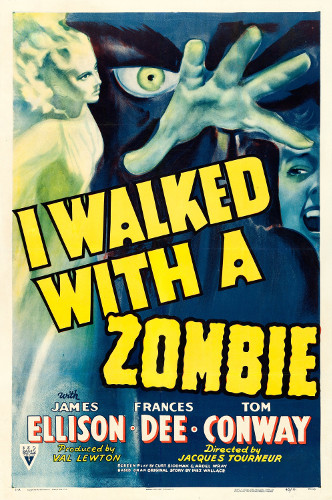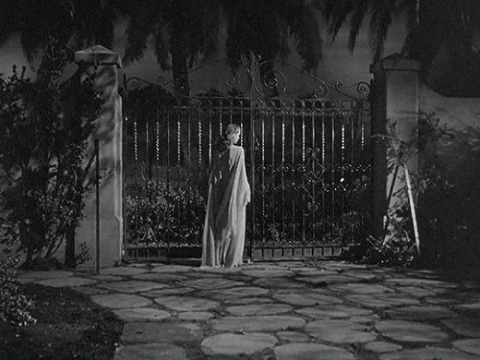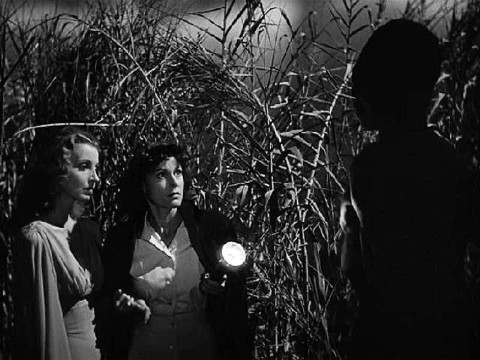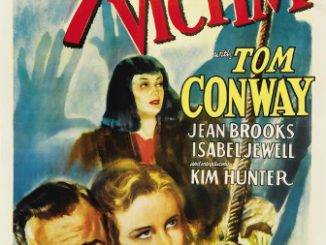I Walked with a Zombie (1943)
Directed by: Jacques Tourneur
Written by: Ardel Wray, Charlotte Brontë, Curt Siodmak, Inez Wallace
Starring: Edith Barrett, Frances Dee, James Ellison, Tom Conway
USA
AVAILABLE ON BLU-RAY [Japan region free] AND DVD
RUNNING TIME: 69 mins
REVIEWED BY: Dr Lenera, Official HCF Critic
Nurse Betsy is hired to care for Jessica the wife of Paul Holland, a sugar plantation owner on the Caribbean island of Saint Sebastian, which is home to a small white community and descendants of African slaves. Once there, she learns that Jessica’s spinal cord was irreparably damaged by a tropical fever, leaving her totally speechless and with no will power. Betsy also meets Wesley Rand, Paul’s alcoholic half-brother and employee who hates Paul for some reason. Jessica begins to fall for Paul and sets out to cure Jessica for him – which means being entangled in the local customs as well as the family’s sordid past.…
I usually watch a film and then write the majority of my review immediately after, but sometimes I’ll view one late at night taking notes, then do the write-up in the morning. And late at night was definitely the perfect time to view this second of producer Val Lewton’s series of highly subtle, moody micro-budgeted horror movies. As I sit here beginning to bash this review out, I can still feel, indeed almost touch the astonishing atmosphere that Lewton and director Jacques Tourneur were able to conjure up, atmosphere that wafted through my bedroom creepily yet also somehow soothingly last night as I watched it – and yet if you boil it down all you really get are the sounds of rustling trees, cooing birds, distant drums, and a hell of a lot of the two main female characters wondering about at night around a house or through cornfields while the day-for-night technique employed means that it doesn’t even feel like night time most of the time. But the thing is I never tire of this kind of stuff, the Gothic horror lover in me can never get enough of ladies in white nightgowns stupidly going up some sinister stairs or down a forbidding corridor. Of course the title may be misleading. There is a probable zombie in the film, one of the screen’s most frightening even though this was made two and a half decades before the living dead in movies became flesh eaters [thanks to George Romero], but whether the person named Jessica is actually undead is left up to the viewer to decide in this in what is really quite an ambiguous piece. While Cat People is undoubtedly a minor classic with a great deal of interest and to praise, and with some incredible scenes, for me I Walked With A Zombie is a more fully achieved work from beginning to end, the Lewton style now fully formed in what is a darkly beautiful artistic endeavour with a distinct and distinctly appealing political subtext that’s unusual for the time.
I Walked With A Zombie went into production only two months after Cat People, so had clearly been planned before that film had been released and luckily become a major hit – which is amazing seeing how ‘arty’ it turned out to be. The RKO executives culled the title from an article of the same name written by Inez Wallace for American Weekly Magazine which detailed her own experience meeting “zombies” — not the literal living dead, but rather people she had encountered working on a plantation in Haiti whose vocal cords and cognitive abilities had been impaired by drug use, rendering them obedient servants who understood and followed simple orders. Lewton didn’t like the article much, so he asked screenwriter Kurt Siodmak to use Jane Eyre as a model for the narrative, and to undertake research on Haitian voodoo practices, though the story remained credited in the titles. Ardel Wray and Lewton made significant revisions to the script that were usually cuts, notably removing references to the colony being American, some more conventional shock moments like a scarred face and a bat attack, and an upbeat epilogue. Anna Lee was originally slated to play Betsy, but had to bow out due to another commitment. Location shooting was cut by five days due to wartime gasoline rationing, meaning that the film took just under a month to be shot. Despite very mixed reviews, it was another major success at the box office. 2002’s Ritual was a remake – and I’m going to have to hunt it down even though I know I’m going to be hugely disappointed.
“I once walked with a zombie” are the first words we here as we see two people at a distance walking along a beach in an opening possibly inspired by Rebecca’s, “last night I went to Manderlay” – which is appropriate I guess seeing as Daphne du Maurier’s story isn’t that dissimilar to Charlotte Bronte’s and the Edward Rochester substitute in this movie often seems more like Max de Winter. The folk walking seem to be Betsy and a zombie, yet this scene never happens in the narrative proper! Knowing that the heroine will survive in a horror isn’t of course a good idea usually, but one soon forgets that as we become engrossed. Betsy’s job interview includes her being asked the odd question, “do you believe in witchcraft?”, but of course she still takes the job anyway without knowing much in the way of details. On the ship en route to her destination, we get a very strange device, especially for the time, that almost breaks the fourth wall when Betsy’s voice-over, vocalising her thoughts as she looks out at the sea, is interrupted by Paul who seems to have actually heard her when she was thinking, “it’s beautiful”! Paul’s reply virtually sums up what seems to me to be one of Lewton’s major themes: “there is no beauty here, only death and pretense – the flying fish jump to avoid being devoured by bigger fish and the phosphorescence comes from dead bodies“. Things which can look really nice can also look bad from another point of view and death is the overriding factor. Despite Paul speaking such cheerful stuff, Betsy already seems to have the hots of the gloomy yet somehow charismatic guy. Then we get the first instance of the film’s subtle but definitely present racial commentary, when Betsy innocently says that the slaves must have been happy to have been brought to such a beautiful place and her buggy driver replies, “if you say so, miss, if you say so.”
Once at the house, it’s not long before we get the first set piece which must have scared the hell out of 1943 viewers. Betsy hears the sound of a woman weeping [soon to be a cliche, but probably not one back then] and of course goes to ‘The Tower’ [!] to investigate. The visuals virtually become expressionistic before our very eyes as she goes up steps enveloped in darkness to a room where a macabre woman appears to lurch at her. This is, of course, Jessica, though she’s not actually dangerous, just suffering from this bizarre illness. Hanging on the wall in her room is Arnold Böcklin’s painting ‘Isle of the Dead’, which would serve as the basis for another Lewton production with that title. There’s a lot of chat for the next 20 minutes or so as we gradually get to know Paul and his half-brother Wesley, though I wouldn’t say that things are slow – scenes are really quite quick and tight, boiled down to the basics. In fact, maybe they’re sometimes boiled down too much to the basics – for example we don’t really get a sense of Betsy and Paul falling in love, and could have done with an extra scene or two involving them. But on the other hand the way that some important background information is told to us in a calypso song performed in a bar in front of Betsy and a drunken Paul is masterly; it’s exposition but also works as a threat against Betsy and even as a very subtle protest song. So what was it that happened? Well, Wesley and Jessica fell in love but Paul stopped them from running away together, after which Jessica was mysteriously struck down by the fever. After Dr. Maxwell has suggested shock treatment, Betsy decides to find the ‘cure’ herself in what is an act of love for her employer. She and Wesley’s mother [played by the obviously far too old Christine Gordon, Vincent Price’s first wife] become involved with the local voodoo.
We do see voodoo magic, but end the film not seeming to know a great deal. Who caused the malady and why? We’re given several possibilities but no real confirmation of any of them, which is really quite extraordinary for 1943. There aren’t even any clear-cut villains. No less than four characters seem to verge on adopting that role but nothing is confirmed and we’re left with trying to piece a hell of a lot together ourselves, which definitely seems to be intended rather than being evidence of a not properly thought through or finished screenplay. It’s not even confirmed if the forbidding zombie we see [or more often hear – the sound of his feet scraping on the ground due to his shuffling walk is wonderfully sinister] is really a zombie – we just assume he is. However, the way his face appears to show considerable pain may haunt the mind for months, Ken Darby being able to bring a touch of pathos to the part despite having no lines. We first meet him as Betsy and Jessica walk through the plantation to where the voodoo ceremonies are performed, the scene having a really vivid dream-like feel, as if the characters are passing through some kind of limbo between our world and the next. The fact that it takes place in an obvious set increases rather than limits the effect, much as in the films of Mario Bava, who along with Roger Corman must have been greatly influenced by this movie. The major scenes tend to be unscored too, composer Roy Webb focusing on the romantic element. His moody music is pleasant though I’d have personally preferred a score which, at least in part, reflected the setting. Cinematographer J. Roy Hart both replicates and improves on the work of his predecessor Nicholas Musuraca, with some interesting character compositions, some lovely long takes with the camera sometimes prowling around the house, some scenes partly shot with obstructions in the way like gauze, and more lines from things like blinds reflecting on walls than in any film noir I’ve ever seen.
Frances Dee projects the right romantic naivety and then determination as Betsy, even if the character doesn’t always make much sense – but then neither do we at times. I was impressed with the way Tom Conway, who was so good as the slimy Dr. Oliver Reed in Cat People, was able to convincingly play a much more likeable character yet still with that exact same voice which sounded so lecherous previously. And the black cast members are mostly given a chance to shine – Theresa Harris as Alma the maid perhaps being most prominent – and play characters who are handled with dignity and respect. Of course this isn’t explicitly stated, but it’s certainly hinted that what seems to be a curse on this family could stem from its past as slave owners. We get a real sense of an island full of sad souls whose one major defiance of white rule is their voodoo religion which they know they are safe with because the whites mostly dismiss it or fear it. Especially poignant is the native tradition of crying when a baby is born, a tradition enacted because the black people are used to having children being born into great hardship. But nothing’s rammed down your throat and it’s possible to ignore all this and just appreciate the film as a mood piece. I remember once reading claims that I Walked With A Zombie isn’t really horror. Indeed it’s first and foremost interested in the creation of an eerie and unsettling ambience, but I think that it can still most definitely be counted as horror. The time in which I watched it may well indeed have been a contributing factor [even I would admit that films such as this don’t always work well during the day when there are more distractions], but I loved this rather delicate, quiet [you never hear a voice raised except for one scream] yet resonant, rich and thought provoking little gem. I’m only annoyed that it took me this long to see it.
Rating: 

















I WALKED WITH A ZOMBIE< contrary to your description, is NOT available on Blu-ray. It hasn't even been announced…yet. Don't get your readers' hopes up only for them to be dashed.
I should have specified that the Blu-ray is a Japanese release which is Region Free, so my apologies for that. It can, however, easily be found on Amazon.
I’ve watched a LOT of horror and sci fi over the years of all levels of goryness (if that’s even a word), and I can honestly say this film is the one that affected me the most at the time of watching. The atmosphere it creates, and the scene with the “zombie”, that gave me actual nightmares, no horror film before or since has ever done that, even to the point of waking one night and thinking he’s stood at the bottom of my bed! That, surely, has to be the sign of a great film and great filmaker (Cat People is another b/w favourite as well)
Thanks for your comment and I totally agree – something about the zombie in this film, and indeed the whole vibe, is incredibly unsettling. I;m sure if I’d watched it at a younger age it would have given me nightmares too. As it is, it has stayed with me since I saw it for the first time only two years ago when I wrote the review, I can still picture some of the shots and feel the atmosphere. A very special horror movie.